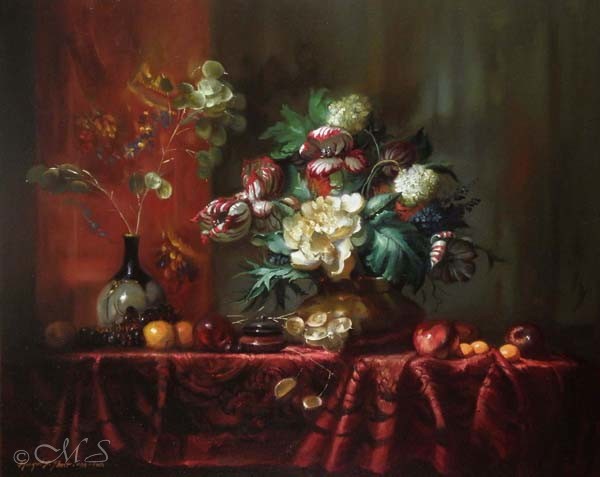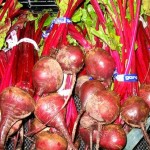While reading a very colorful article this morning, I thought about my painting, Dutch Treat, shown below. The article, entitled “Sensational Color, Sexy Beets”, from Color Expert Kate Smith of Sensational Color describes the love/hate relationship people have with beets. Some find them totally unpalatable, including Former President Obama, who brazenly gave them the brush off. Others claim to experience a gritty impasto-ish texture. And yet, many others see great value in their usefulness – as a source of nutrition and color!
One thing I will say about this highly pigmented plant: the hues are spectacular! The lover of the beetroot (and color) may canvas produce sections for Albina Veredunas (white), Burpee’s Golden (orange-red skin with yellow flesh), Chioggia (red and white rings), the Detroit Dark (purple), and the award-winning Red Ace.
To be sure, this much-maligned vegetable did not exactly come to mind while painting my new piece. However, the scarf I used in the piece contains muted alizarin and red tints – hues that are common with that pungent earthy flavor found in those contentious tubers. While reading that article, I could relate immediately to the logical concept of beet and art comparisons.

Actually, to their defense, beets did not always have a shady past. They have been a useful food staple all over the world for many centuries including Ancient Egypt in Saqqara. Here in Thebes, historians found beetroots in their excavations. The earliest mention of them comes from the 8th century BC in Mesopotamia. The many uses for the varied pigments include food colorings and other dyeing processes.
My son-in-law, Craig, and grandson Jordan, both turn green at the mention of beets, but a friend tricked them once with this recipe:
Chocolate Beet Cake
You’ll need:
- Duncan Hines chocolate cake mix
- One box instant chocolate pudding
- l c. beets pureed in a blender
- 1/2 c. mayo
- 4 eggs
- 1 tsp. baking soda
- 1 1/3 c. water.
Mix the dry ingredients, add the wet to dry, and beet for 2 minutes with an electric beater. Bake 350 for 45 minutes in a 9 x 13 pan.
Ha! She hooked them! It was a total success.
The greens of a beet are also full of nutrients such as vitamins E and anti-oxidants. Many people also use beets in music as rhythm aids. So next time you are carousing around that salad bar, sample some! Down the hatch, live it up. Maybe you will experience some joie de vivre lurking in this ancient cultivar known as the lowly reviled/venerated but worldly sexy beet.
This blog was originally posted in 2010 (seems only a heartBEET ago!)


Hi Margret,
I LOVE steamed beets AND sauteed beet greens! I discovered the wonderfulness of the greens last summer and now when I buy my fresh beets, I make sure the greens look terrific, too! BTW, I just discovered your blog while rambling around googling stuff on art show wall labels and came across ArtBizBlog and the interview with you. Now I’m going to roam around your blog a bit, but had to mention my love for the beet when I saw this post! Cheers, Sparky
http://sparky-youngbloodstudios.blogspot.com/
Hi Margret,
Nicely done. You make it look effortless.
For all the effort you put into the sexy beet palette, in honoring their incredible colors, I would be remiss if I did not recommend Tom Robbins’ 1984 book, Jitterbug Perfume. You will love this story.
Howdy Margret, I was stunned by both your art AND the recipe for chocolate beet cake My mother used to make one that was a county fair winner in Montana. I will compare the recipes. perhaps paint a beet or two as well. J.R.
wow!! excellent work.. keep it up…..
I love beets but I love your painting here more! It’s gorgeous.
I especially enjoy my hands after I’ve handled beets. I love the purple-red mess they make!
Don’t like beets either. But dying threads with it are great. May have to try this recipe! May be a convert as well
Hello Becky, It does seem like beets are disliked by many. As to using the beet juice as a dye: is it permanent? Do you set the color? I am very curious to know your process and results. Margret